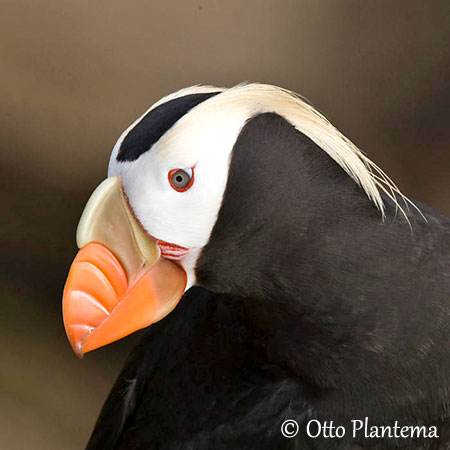
Fr: Macareux huppé
All : Gelbschopflund
Esp : Frailecillo Coletudo
Ital : Pulcinella dai ciuffi
Nd: Kuifpapegaaiduiker
Sd: Tofslunne
Photographers:
Tom Grey
Tom Grey's Bird Pictures
Tom Merigan
Tom Merigan’s Photo Galleries
Otto Plantema
Trips around the world
Text by Nicole Bouglouan
Sources:
HANDBOOK OF THE BIRDS OF THE WORLD Vol 3 by Josep del Hoyo-Andrew Elliott-Jordi Sargatal - Lynx Edicions - ISBN : 8487334202
BirdLife International (BirdLife International)
All About Birds (Cornell Lab of Ornithology)
ANIMALS – Explore, discover, connect
Bird Web (Seattle Audubon Society)
Wikipedia, the free encyclopaedia
Tufted Puffin
Fratercula cirrhata
Charadriiforme Order – Alcidae family
BIOMETRICS:
Length: 36-41 cm
Weight: 773 g
DESCRIPTION:
The Tufted Puffin differs from Atlantic Puffin and Horned Puffin by its dark body. These three puffins belong to the genus Fratercula which means “little brother”. All have the large, typical, laterally compressed beak.
The adult in breeding plumage has blackish body and white face.
On the head, the large bill is red and laterally compressed. On the upper mandible, the basal part is yellowish/greenish with yellow ridge. The fleshy gape is red.
Face and chin are white whereas crown, nape and throat are black. We can see two long creamy-buff post-ocular tufts reaching the nape.
The eyes are pale yellow, surrounded by red eye-ring. Legs and webbed feet are reddish-orange, with curved, sharp black claws.

RANGE:
The Tufted Puffin is found in N Pacific Ocean. This species breeds from S British Columbia (several sites off the Washington and Oregon coast), throughout SE Alaska and the Aleutian Islands, Kamchatka, the Kuril Islands and throughout the Sea of Okhotsk. The southernmost site, the Farallon Islands shelters a small breeding population, less than 100 pairs.)
It winters at sea along the coasts of Kamchatka Peninsula and S Alaska, through the breeding range.

The Tufted Puffins are monogamous with long-lived pair-bonds. They perform some displays to strengthen the bond, such as the “billing” courtship ceremony.
Both mates defend the nest-site by using threat displays. They may fight too, but usually, fighting is short. They utter grunts or growls at the nesting colonies.
The Tufted Puffin winters at sea, well offshore. It performs post-breeding dispersions, solitary or in pairs. They may move S to waters off S Japan and S California. They return to the colonies in late April and May.

FLIGHT:
The Tufted Puffin shows a stocky black body when flying. It has short, narrow wings, better for underwater pursuit than flight. The flight is laboured, and to take-off from water, it must run some distance over the surface to rise into the air. It is however a powerful flier, able to perform strong wingbeats.

REPRODUCTION:
The peak of laying occurs between late May and mid-June, with some variations of about 1-3 weeks according to the breeding range. The laying is usually highly synchronised within the colony.
The Tufted Puffin breeds in small to huge colonies, mainly on steep maritime grassy slopes. This species nests in burrows excavated in sea-facing grassy slopes and flats. Like the Horned Puffin, it also may nest in crevices or cavities in cliffs and boulders.
The singly egg is laid in a rough scrape at the end of the burrow. This scrape is often lined with feathers and dry vegetation. Both sexes incubate during 45-46 days, with periods of 12-24 hours for each adult.
At hatching, the downy chick is sooty black above and paler below. It is semi-precocial. Both parents feed and care the chick during 49-50 days. Then, the young fledges at night and goes out to the sea, probably alone.

The main predators are Bald Eagles, gulls, ravens, Snowy Owls, arctic foxes, rats and humans.
DIET:
The Tufted Puffin feeds on small fish, squid, krill, shrimps, crabs and marine worms. It performs pursuit-diving at considerable depths, up to 40-50 metres.
PROTECTION / THREATS / STATUS:
The Tufted Puffin has large populations throughout the range. Severe declines due to introduced predators such as rats, foxes, cats and dogs, are reported over the last 150 years in most of breeding range.
Human disturbances on breeding islands are important threat too.
However, this species is not currently globally threatened.
In winter plumage, the Tufted Puffin has dark body and head, and tufts are absent. The bill is duller and appears smaller and longer, less triangular. The basal ridge is lacking too. Eye-ring, legs and feet are much paler.
Both sexes are similar, with male slightly larger than female.
The juvenile resembles winter adult. It has paler underparts, mostly grey-brown, shading to white on belly. The yellowish bill is smaller.
VOICE:
The Tufted Puffin, as other puffins, is mostly silent outside colonies where it utters some “arrr” sounds, groans and raucous growls.



